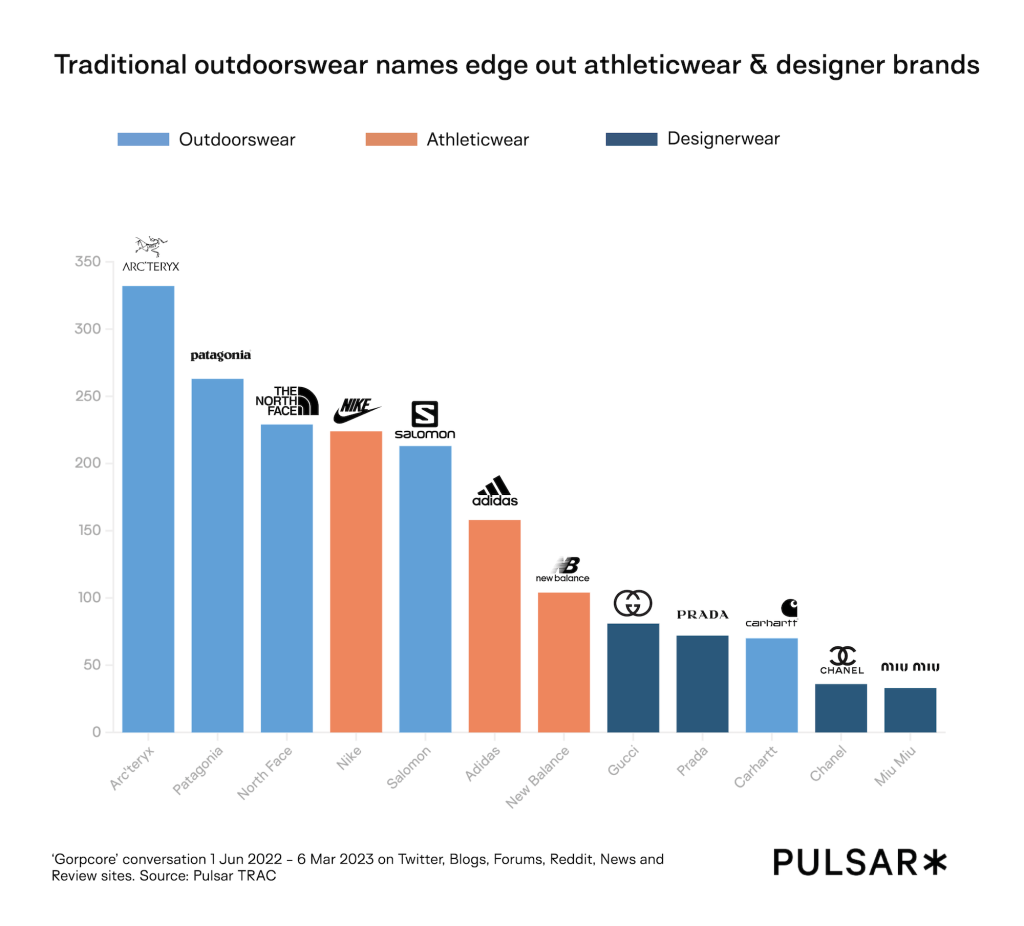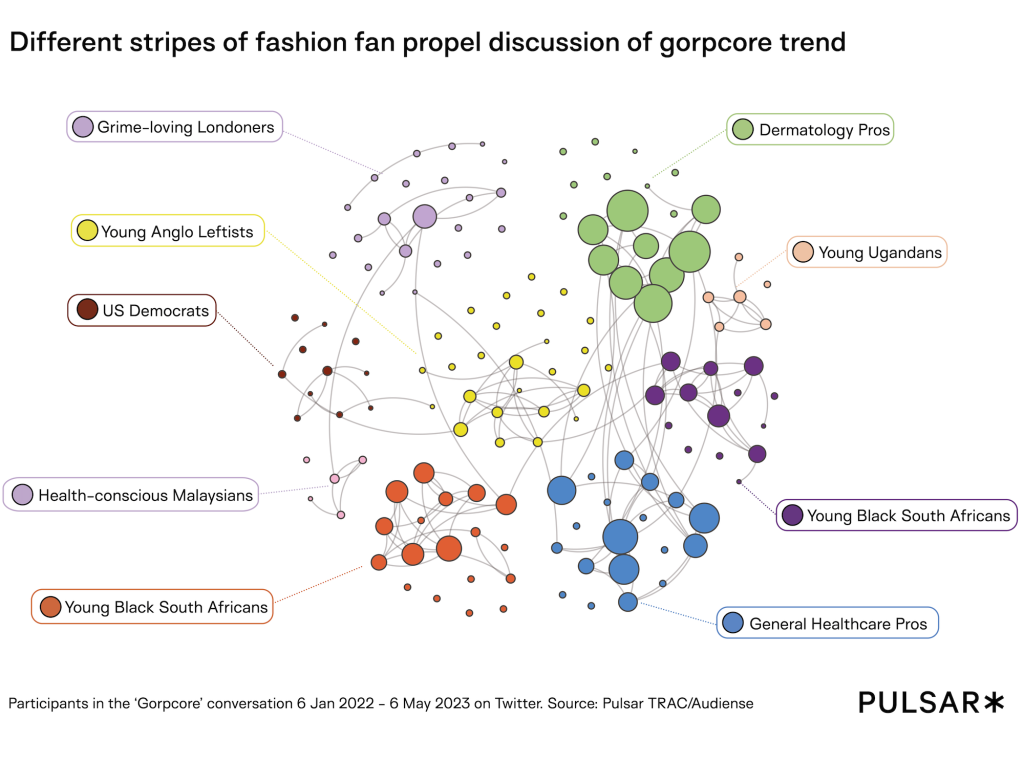
Unzipping the gorpcore trend to understand the brands & communities driving it
- Fashion
Walk through any temperate city and you’ll get the sense that a growing minority are preparing for a snowstorm that never quite materializes. It might have started with the odd Patagonia bag, or occasional North Face jacket, but what you’re witnessing isn’t a wave of outdoor living enthusiasts: it’s gorpcore.
A fashion trend that unites A-listers, streetwear enthusiasts, and even those with an avowed dislike of high fashion, gorpcore essentially involves taking garments and brands familiar from cold outdoors activity, such as puffer jackets or Arc'teryx, and wearing them in everyday or fashion-conscious settings.
if you're curious abt this: he was talking abt fashion style called gorpcore which is focused around wearing utilitarian, functional, outdoors-inspired gear such as fleece jackets, parkas, gore-tex jackets and pants. https://t.co/wV5FC9AVOA pic.twitter.com/z9qv6Pykwh
— 𝒅𝒂𝒓𝒂🌻 (@taecmyheart_) January 18, 2023
Analysis of search and social data would suggest that the term was being used as far back as 2017. However, it was only in recent years that it’s moved from isolated seller listings and the occasional mention, into something resembling a coherent trend.
Will this trend of bulky layers and technical clothing survive through to the warmer months?
To answer this, we can use Pulsar TRAC to analyze tens of thousand of individual conversations, as they take place across Twitter, Blogs, News, Podcasts, Twitch, Reddit and more besides.
And the first port of call is to look at which brands are most identified with the trend. Unsurprisingly, it’s those with a long pedigree in supplying generations of intrepid workers and adventurers - Patagonia, North Face and Arc’teryx.

This, of course, isn’t the first time that these ostensibly ‘active’ brands have intersected with more sedentary and city-bound elements within mainstream culture. The Patagonia vest, for instance, has long been an identifying uniform for VCs, bankers and tech managers.
The key difference between that phenomenon, and that of gorpcore, is that the technical vest, worn with smart shirts and shoes in sweeping glass offices, became appropriated by that stratum of business. Gorpcore, by contrast, is far more totalistic an aesthetic. Ski jackets and chunky, snowdrift-friendly boots are not so easily assimilated, but rather act as statement signifiers of identity.
And this is reflected in the types of garment that lead discussion:
Jackets dominate, and epitomize some of the potential drivers behind the trend.
Gorpcore is a trend that, while not as exclusive as some within fashion, nonetheless presents cost barriers to entry - a lot of this gear is expensive. And so, perhaps one driver is the need of relatively well-off individuals to infuse relatively comfortable lives with a sense of hard-wearing outdoorsiness.
That expense can similarly see jackets act as simple reflections of wealth and status. In South Korea, for instance, wearing expensive ‘spinebreaker’ jackets from brands such as The North Face has become an important signifier of wealth of status for students - a trend that can continue in young adulthood.
Lastly there’s also a vaguely apocalyptic element - one that’s perhaps reflective of our cultural anxieties, and the sense that we’re moving into an increasingly utilitarian, potentially austere world impacted by climate and economic downturn.
By delving into the type of language used by participants within the gorpcore conversation, we can look for clues as to how they conceptualize the trend. Using Pulsar TRAC, we can set language that incorporates practicality (such as weather, comfort and activity) against that which covers aesthetics (individual trends, fashion-adjacent phrasings).
This tells us that the most mentioned brands (outdoorswear names like Patagonia, Arc’teryx and The North Face, as well as athleticwear outliers Nike) don’t only lead the aesthetics conversation, but also attract the most references to practical concerns. It suggests that practical terms can be a signifier of authenticity, and that consumers are attracted to brands that don’t just reflect the aesthetic trappings of the trend, but epitomize underlying lifestyle and values.
By contrast, designerwear brands that have entered the space, together with athletic brands like Adidas and New Balance, are far less associated with practicality. An indication of where the trend is going?
Certainly, when we investigate who it is taking part in discussion, the trend appears accommodate greater numbers who care about, and display strong online affinities towards, designer brands.

We can divide the communities taking part in this conversation into three categories:
- Niche fashion groups, outside the fashion mainstream, such as Fashionista Students or Manchesterphiles. The former prefer independent, adventurous creators, while the latter gravitate towards the kind of half-mod, half-technical jackets linked to Mancunian music and football fans.
- Mainstream fashion groups, such as Menswear Enthusiasts and Glossy Mag Fashion Fans, each display a far greater affinity for clothing than is found within the wider population - but the accounts they follow are more reflective of mainstream concerns, like popular menswear influencers or the Vogue family of magazines.
- Finally, there are the fandoms who have encountered the trend through different means, not tied to necessarily purchasing and wearing the gear themselves. This includes Crypto x Art fans, who are interested in the buying and selling of gorpcore NFTs, as well as Day6 K-pop Stans, who discuss the stylings of their favorite band members.
If we focus on these groups with the most tangible links to gorpcore as a wearable trend, then we see that engagement levels fluctuate.
Menswear Enthusiasts appear to have been earliest onto the trend - slightly unusually for an emergent fashion trends this appears to have been one adopted initially by men, which is only upon a later stage of maturity being adopted more universally.
The more recent explosion of interest amongst Menswear Enthusiasts is reflective in part of simple seasonal cycles - and a re-entry into the colder months. But it also displays instances of gatekeeping behavior. As the trend moves into other audiences, the Menswear Enthusiasts who had already been aware of the trend engage with ironic, or mocking posts, that seem intended on some level to suggest other communities are late to the party.
This includes audiences such as Glossy Mag Fashion Fans, who tend to engage with the trend as it’s discussed in high end fashion publications. Their participation has happened in tangent with an increasingly number of celebrities being folded into conversation - Bella Hadid, Kendall Jenner and Hailey Bieber were each detected by Pulsar’s entity detection AI, particularly within ‘inspo’ posts
So, is gorpcore going to stick around? The diversification amongst the communities drawn to the trend, and their differing patterns of engagement, suggest that it has more staying power than those that rise and fall amongst more monolithic audiences. And then there's the fact the a kind of 'soft gorpcore', such as simply purchasing multiple Patagonia or The North Face products, appears likely to survive and transcend gorpcore as a transgressive, high-fashion movement.
This article was created using data from TRAC
